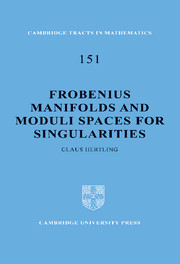Book contents
- Frontmatter
- Contents
- Preface
- Part 1 Multiplication on the tangent bundle
- 1 Introduction to part 1
- 2 Definition and first properties of F-manifolds
- 3 Massive F-manifolds and Lagrange maps
- 4 Discriminants and modality of F-manifolds
- 5 Singularities and Coxeter groups
- Part 2 Frobenius manifolds, Gauß–Manin connections, and moduli spaces for hypersurface singularities
- Bibliography
- Index
5 - Singularities and Coxeter groups
from Part 1 - Multiplication on the tangent bundle
Published online by Cambridge University Press: 12 September 2009
- Frontmatter
- Contents
- Preface
- Part 1 Multiplication on the tangent bundle
- 1 Introduction to part 1
- 2 Definition and first properties of F-manifolds
- 3 Massive F-manifolds and Lagrange maps
- 4 Discriminants and modality of F-manifolds
- 5 Singularities and Coxeter groups
- Part 2 Frobenius manifolds, Gauß–Manin connections, and moduli spaces for hypersurface singularities
- Bibliography
- Index
Summary
In this section several families of massive F-manifolds which come from singularity theory are studied. The most important ones are the base spaces of semiuniversal unfoldings of hypersurface singularities. Three reasons for this are: (1) hypersurface singularities and their unfoldings are so universal objects; (2) their F-manifolds can be enriched to Frobenius manifolds (part 2); (3) one has a 1-1 correspondence between irreducible germs of massive F-manifolds with smooth analytic spectrum and stable right equivalence classes of singularities (Theorem 5.6). This is covered in section 5.1. The discussion of boundary singularities and their F-manifolds in section 5.2 is quite similar.
Sections 5.3 and 5.4 are devoted to finite irreducible Coxeter groups and their F-manifolds and Frobenius manifolds. The discriminant in the complex orbit space induces an F-manifold structure on the orbit space just as in Corollary 4.6. This follows independently from work of Dubrovin and from results in singularity theory by Brieskorn, Arnold, O.P. Shcherbak, Givental. We extend work of Givental in order to characterize these F-manifolds (Theorems 5.20, 5.21, 5.22) and use this to prove a conjecture of Dubrovin about the corresponding Frobenius manifolds (Theorem 5.26).
In section 5.5 other families of F-manifolds with quite different properties are constructed. A start is made on the classification of 3-dimensional germs of massive F-manifolds.
- Type
- Chapter
- Information
- Frobenius Manifolds and Moduli Spaces for Singularities , pp. 61 - 96Publisher: Cambridge University PressPrint publication year: 2002

